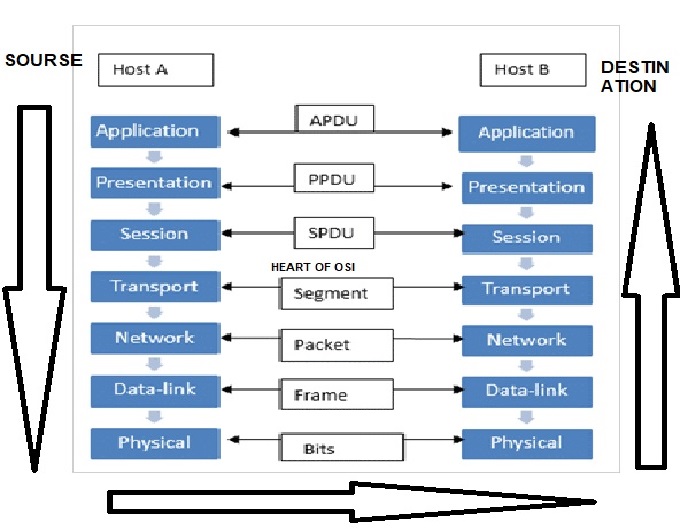When we talk about network then first we think network security. Network security can be understood with the help of OSI reference model of 7 layers. each layer has its specific work to provide reliable communication between devices. here we EXPLAIN OSI LAYER WITH EXAMPLE . before exaplaining OSI model first we see internet, intranet, extranet. lets check.
Read Also: believe or Not PAKISTAN MAKING LOCUSTS/ TIDDI BIRYANI
NETWORK: A network is a collection of computers, servers, mainframes, network devices, peripherals, or other devices connected to one another to allow the sharing of data.
INTERNET: Network of networks worldwide.
INTRANET: It is a private network within an organisation.
EXTRANET: It is extended version version of intranet with internet. It can be accesses by specific user like vendor, customer, suppliers etc. Outside the organisation.
To watch this lecture on you tube https://youtu.be/kIrDPldGDjc
EXPLAIN OSI LAYER WITH EXAMPLE :
OSI LAYER REFERENCE MODEL:
OSI stands for Open System Interconnection(OSI) is a reference model that describes how information from a software application in one computer moves through a physical medium to the software application in another computer. it consists of seven layers, and each layer performs a particular network function. this model was developed by the International Organization for Standardization (ISO) in 1984, and it is now considered as an architectural model for the inter-computer communications.
OSI model divides the whole task into seven smaller and manageable tasks. Each layer is assigned a particular task.
Each layer is self-contained, so that task assigned to each layer can be performed independently.
All Characteristics of OSI Model:
The OSI model is divided into two layers: upper layers(USER SUPPORT) and lower layers(NETWORK SUPPORT). upper layer deal with user needs and it is a software part NO hardware required. Lower layer uses software as well as hardware devices like hub, switch, router, repeater, cable, nic card, etc.
Functions of the OSI 7 Layers:
EXPLAIN OSI LAYER WITH EXAMPLE -> WE can take a simple example to understand seven layers functioning. let user wan to access online banking account like onlinesbi with user name and password. first user click on web browser application software, at the same time Application layer works. Now user type www. onlinesbi .com and page display on computer, at this time presentation layer works (it represent the page according to user need). after it user put username and password, at this time session layer authenticate and create session for user on sbi server. these information transfer to transport layer, transport layer transfer the data and convert it into segments, send to network layer. Network layer find shortest route for communication and convert segments to packets with source, destination address and send to data link layer. Now data link layer convert packet to frames and send to physical layer. finally physically layer convert frames to bits and send through media like cable, devices, etc.
finally data reach sbi server and server authenticate user and create session. Now user access their account on computer.
TYPES OF OSI LAYER:
There are the seven OSI layers. Each layer has different functions. A list of seven layers are given below:
- Physical Layer
- Data-Link Layer
- Network Layer
- Transport Layer
- Session Layer
- Presentation Layer
- Application Layer
Application Layer: it provide window for users and provide application for network service.
Presentation Layer: it act as a data translator, it is part of operating system and convert data one format to other. It provide encryption, decryption and compression.
Session Layer: generate session for communication like single or multiple session.
Transport Layer: It is heart of OSI layers. Main responsibility is to transfer data completely. receive data from upper layer and convert to segments.
Also known end-t-end layer and provide point to point connection.
Two protocol used TCP(transmission control protocol) and UDP(user datagram protocol)
Network Layer: it provide routing service and determine best route, add source and destination address to the header of frame, collect segments from upper layer and convert into packets.
Data-Link Layer: it convert packet to frame and insert destination address into frames. it also control flow and error control.
Physical Layer: The main functionality of the physical layer is to transmit the individual bits from one node to another node. It is the lowest layer of the OSI model. It establishes, maintains and deactivates the physical connection.
DEVICES AND PROTOCOL USED IN OSI MODEL:
AS we know first three layers(physical, data, transport) are network support layer. these layer use both hardware devices and software. But rest four layer use only software. all layers protocols and devices given here check it.

